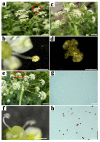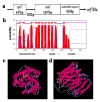Complete Mitochondrial Genome Sequence and Identification of a Candidate Gene Responsible for Cytoplasmic Male Sterility in Celery (Apium graveolens L.)
- PMID: 34445290
- PMCID: PMC8395238
- DOI: 10.3390/ijms22168584
Complete Mitochondrial Genome Sequence and Identification of a Candidate Gene Responsible for Cytoplasmic Male Sterility in Celery (Apium graveolens L.)
Abstract
Celery (Apium graveolens L.) is an important leafy vegetable worldwide. The development of F1 hybrids in celery is highly dependent on cytoplasmic male sterility (CMS) because emasculation is difficult. In this study, we first report a celery CMS, which was found in a high-generation inbred line population of the Chinese celery "tanzhixiangqin". Comparative analysis, following sequencing and assembly of the complete mitochondrial genome sequences for this celery CMS line and its maintainer line, revealed that there are 21 unique regions in the celery CMS line and these unique regions contain 15 ORFs. Among these ORFs, only orf768a is a chimeric gene, consisting of 1497 bp sequences of the cox1 gene and 810 bp unidentified sequences located in the unique region, and the predicted protein product of orf768a possesses 11 transmembrane domains. In summary, the results of this study indicate that orf768a is likely to be a strong candidate gene for CMS induction in celery. In addition, orf768a can be a co-segregate marker, which can be used to screen CMS in celery.
Keywords: CMS-associated gene; celery; cytoplasmic male sterility (CMS); mitochondrial genome.
Conflict of interest statement
The authors declare no conflict of interest.
Figures






References
-
- Okazaki M., Kazama T., Murata H., Motomura K., Toriyama K. Whole mitochondrial genome sequencing and transcriptional analysis to uncover an RT102-type cytoplasmic male sterility-associated candidate gene derived from Oryza rufipogon. Plant Cell Physiol. 2013;54:1560–1568. doi: 10.1093/pcp/pct102. - DOI - PubMed
MeSH terms
LinkOut - more resources
Full Text Sources

